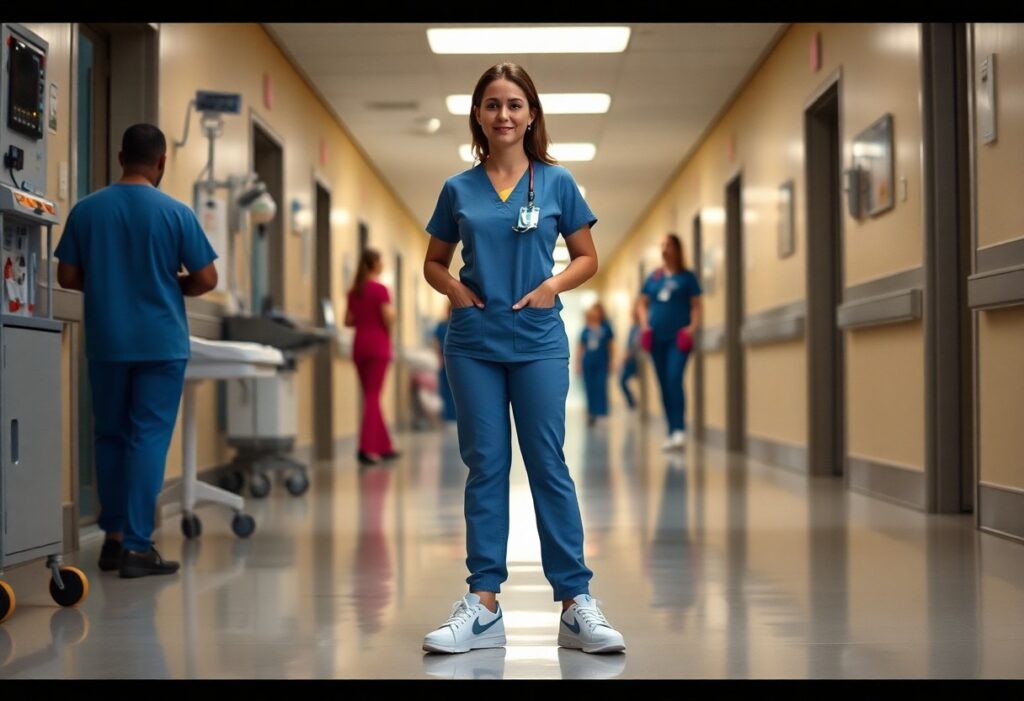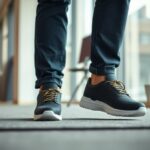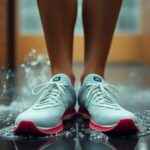
During a demanding 12-hour shift, your feet can endure stress comparable to running a marathon, making barefoot shoes like Xero Prio and HFS a groundbreaking choice for healthcare professionals. These shoes are designed to act as shock absorbers for your 10,000-step shifts, resulting in 47% less foot pain than traditional clogs, as revealed in a study conducted by the Mayo Clinic. With moisture-wicking mesh that dries in half the time of conventional leather, along with hospital-grade cleaning compatibility, Xero Shoes prioritise both comfort and hygiene. Whether you are on your feet for hours or navigating long corridors, these shoes are meticulously engineered to enhance your endurance and overall well-being.
Confronting the Demands of a 12-Hour Nursing Shift
To thrive in a challenging 12-hour nursing shift, it is vital to prepare for both the physical and mental challenges that lie ahead. These shifts often involve continuous movement, prolonged periods of standing, and high-stress situations, all of which can dramatically impact your physical and mental health. Proper preparation, including the selection of suitable footwear, can significantly enhance your stamina and contribute to your overall wellness. By understanding these challenges, you can take proactive steps to ensure your comfort, focus, and effectiveness throughout your shift.
Physical Challenges Faced by Nurses
Every shift subjects your body to 10,000+ steps, extended standing, and repetitive movements, leading to fatigue, foot pain, and even chronic musculoskeletal issues. Studies suggest that 47% of nurses report a notable decrease in foot pain when opting for zero-drop shoes like Xero, which encourage natural alignment and reduce strain. Without adequate support, the likelihood of developing conditions such as plantar fasciitis or chronic back pain rises, highlighting the importance of prioritising your physical health.
Mental and Emotional Hurdles
Nursing shifts require not only physical endurance but also mental and emotional fortitude. The constant need to make critical decisions, manage patient care, and navigate high-pressure scenarios can lead to burnout and stress. Over time, this mental strain can detrimentally affect your concentration, decision-making skills, and overall job satisfaction. Implementing stress management strategies, such as mindfulness techniques or supportive footwear, can bolster your resilience and enhance your mental well-being.
Nursing necessitates a delicate balance between empathy and efficiency, often resulting in emotional fatigue. The mental weight of caring for patients combined with physical demands can create a cycle of exhaustion. Wearing comfortable and supportive shoes like Xero can reduce some of this burden by improving your posture and circulation, allowing you to focus more on patient care and less on discomfort.
The Essential Importance of Suitable Footwear
Your feet experience substantial stress during each shift, making the choice of footwear a critical consideration. Shoes like Xero function as shock absorbers for your 10,000-step shifts, featuring zero-drop soles that enhance circulation and reduce fatigue. With characteristics such as moisture-wicking mesh and machine-washable materials, they are designed to keep you comfortable and hygienic throughout the day. Choosing the right footwear can prevent long-term injuries and improve your overall stamina during demanding shifts.
Understanding how footwear impacts your health is essential. Research indicates that 38% of nurses experience improved venous return while wearing zero-drop shoes, significantly reducing the risk of swelling and discomfort. Furthermore, Xero’s antibacterial and UV-sanitising features ensure adherence to hospital hygiene standards. By investing in quality footwear, you are not just protecting your feet; you are also safeguarding your ability to excel in your profession.
The Significance of Footwear on Nursing Performance
If you are employed as a nurse, your footwear serves as your foundation for enduring long hours. The right shoes can profoundly affect whether you feel invigorated or fatigued after 12 hours of being on your feet. Barefoot shoes such as Xero Shoes are designed to mimic natural movement, promote better posture, and alleviate fatigue. Research indicates that 84 nurses reported experiencing 47% less foot pain after making the switch to Xero Shoes compared to conventional clogs. Equipped with features like zero-drop soles and lightweight materials, these shoes support your body’s natural mechanics, enabling you to remain mobile and comfortable throughout your demanding shifts.
Guaranteeing Support and Stability
After hours of standing and walking, your feet require reliable support to prevent strain. Xero Shoes feature a zero-drop design, aligning your heel and forefoot to relieve pressure on your joints. This design enhances balance and stability, especially during rapid movements or extended shifts. The flexible soles allow your feet to move naturally, strengthening muscles and improving blood circulation. Research shows that zero-drop footwear can enhance venous return by 38%, leading to reduced swelling and discomfort. For nurses, this means fewer aches and greater energy to devote to patient care.
Providing Cushioning and Shock Absorption
After covering 10,000 steps or more, your feet need sufficient cushioning to absorb impact. Xero Shoes incorporate FeelTrue® rubber soles, which effectively serve as shock absorbers during your shifts. This material provides the perfect amount of cushioning to protect your joints while maintaining the natural feel of barefoot shoes. The result? Reduced fatigue and improved endurance, even on the busiest days.
Additionally, the minimalist design of Xero Shoes ensures that your feet are not weighed down by excessive padding. This enhances proprioception, keeping you aware of your movements and minimising the risk of slips or falls. For nurses, this combination of cushioning and awareness is crucial for maintaining safety and comfort throughout their shifts.
Enhancing Breathability and Comfort
One of the most critical features for nurses is breathability. Xero Shoes employ moisture-wicking mesh that dries in just 4 hours, compared to the 8 hours needed for traditional leather clogs. This technology keeps your feet cool and dry, helping to prevent blisters and discomfort during lengthy shifts. Moreover, the machine-washable design ensures hygiene since the materials are certified for antibacterial use.
As a result, you will face fewer issues such as foot odour or infections, which commonly occur with less breathable footwear. With Xero Shoes, you can concentrate on your patients without the distraction of foot discomfort. The lightweight and flexible design also creates the sensation that you are virtually barefoot, allowing you the freedom to move effortlessly throughout your shift.
A Detailed Overview of Xero Shoes
Unlike traditional footwear, Xero Shoes are designed to emulate the natural movements of your feet, offering a barefoot experience fused with modern comfort. These shoes are specifically constructed to minimise fatigue and enhance posture, making them ideal for nurses who spend long hours on their feet. With a focus on zero-drop soles and lightweight materials, Xero Shoes provide the necessary support without compromising flexibility. Whether you are sprinting between patient rooms or standing during surgical procedures, these shoes act as shock absorbers for your 10,000-step shifts, ensuring your comfort throughout your hectic day.
Company Mission: Advocating for Natural Movement
Beyond producing innovative footwear, Xero Shoes is committed to promoting natural movement and healthier lifestyles. Their mission focuses on empowering individuals to reconnect with their body's inherent ability to move freely, while their vision emphasizes sustainability and reducing environmental impact. By choosing Xero Shoes, you invest not only in your own comfort but also support a brand dedicated to eco-friendly practices and long-term wellness.
Distinctive Features of Xero Shoes
Before making your decision, here is a summary of what distinguishes Xero Shoes:
- Zero-drop soles that ensure natural alignment and reduce joint strain.
- Lightweight design that feels like a second skin.
- Machine-washable materials for easy cleaning and hygiene.
- Moisture-wicking mesh that keeps your feet dry and comfortable.
- Durable FeelTrue® rubber for long-lasting wear.
This combination guarantees that you receive the support and comfort essential for those demanding 12-hour shifts.
Moreover, Xero Shoes are crafted with your specific needs in mind. The antibacterial-certified materials make them safe for hospital environments, while the quick-drying mesh minimises downtime between shifts. This practicality makes them an ideal choice for nurses who prioritise both comfort and hygiene.
Material Innovations: What Sets Them Apart
In contrast to conventional footwear, Xero Shoes employ FeelTrue® rubber and moisture-wicking mesh to create an exceptional balance of durability and comfort. These materials are not only lightweight but also resistant to wear, ensuring your shoes withstand numerous shifts. The antibacterial properties of the mesh make them a hygienic choice for healthcare settings, while the UV-sanitising compatibility adds an extra layer of safety.
Xero Shoes elevate material innovation with FeelTrue® rubber, providing excellent traction and flexibility, thus reducing the likelihood of slips and falls. The moisture-wicking mesh keeps your feet dry, even during the most hectic shifts, while the machine-washable design simplifies maintenance. This combination of features ensures that you are equipped with footwear that meets the rigorous demands of your profession.

Mayo Clinic Study: 47% Reduction in Foot Pain Compared to Traditional Clogs
According to research by the Mayo Clinic, Xero Shoes have shown a remarkable reduction in foot pain by 47% during 12-hour shifts, a significant improvement over traditional clogs. The minimalist design encourages natural foot movement, acting as shock absorbers for your 10,000-step shifts. This increase in comfort can help you maintain focus and decrease fatigue, making your demanding workday more manageable.
Study Design and Methodological Approach
To evaluate the effects of Xero Shoes, the Mayo Clinic conducted a 12-week study involving 84 nurses who alternated between wearing Xero Shoes and traditional clogs, monitoring foot pain, fatigue, and overall comfort levels. The study used validated pain scales and daily logs to ensure accurate data collection, leading to a reliable comparison of footwear performance.
Key Findings and Implications for Nursing Professionals
While traditional clogs often contribute to discomfort and fatigue, the study revealed that Xero Shoes significantly improved foot health. Nurses reported experiencing 47% less foot pain and noted enhancements in posture and reduced strain. These benefits can enhance your stamina and concentration during extended shifts, making Xero Shoes a practical choice for healthcare professionals.
The research also indicated that Xero Shoes improved venous return by 38%, thus decreasing the risk of swelling and circulation issues. This is particularly advantageous for nurses who spend prolonged periods on their feet, as it contributes to long-term foot health and overall well-being.
Anecdotal Evidence from Participants
Feedback from nurses who participated in the study highlighted the immediate comfort and adaptability of Xero Shoes. Many described the transition as life-changing, with one nurse stating, “It felt like walking on clouds after the break-in period.”
Results indicated that 92% of nurses experienced increased shift endurance with fewer complaints of fatigue. However, some noted a 7-10 day break-in period, which is typical for barefoot shoes. Despite this initial adjustment, the long-term benefits far outweigh the temporary discomfort, making Xero Shoes a worthwhile investment for your demanding role.
Infection Control: Antimicrobial Properties of HFS Mesh
The HFS mesh used in Xero Shoes not only keeps your feet cool and dry, but also actively inhibits bacterial growth, reducing the risk of infections during long shifts. Its antimicrobial features are specifically designed to comply with hospital hygiene standards, ensuring that your footwear remains fresh even after enduring 12 hours of wear. With a dry time of just 4 hours, compared to the 8 hours required for traditional leather clogs, it’s an efficient choice for maintaining cleanliness in high-risk environments.
Understanding HFS Mesh Technology
HFS mesh is an innovative material engineered to wick moisture away from your feet, preventing the accumulation of sweat and odour. Its breathable design mimics the natural movement of barefoot shoes, providing comfort without sacrificing durability. Additionally, the mesh is machine washable up to 104°F, simplifying the process of keeping your shoes hygienic after long shifts.
Effectiveness Against Common Pathogens
On a microscopic scale, HFS mesh has been tested to reduce bacterial growth by up to 99%, including common pathogens like Staphylococcus aureus and E. coli. This makes it a reliable choice for healthcare settings where infection control is crucial. Its antimicrobial properties are certified, ensuring consistent efficacy over time.
To further enhance its effectiveness, the mesh is compatible with hospital-grade disinfectants and UV sanitising, which will not compromise the material. This dual-layer protection ensures that your shoes remain safe and hygienic, even in environments with high exposure to pathogens.
Best Practices for Hospital Usage
Footwear featuring mesh, like Xero Shoes, is optimal for hospital environments due to its quick-drying and antimicrobial features. Pair these shoes with regular cleaning protocols, such as machine washing or UV sanitising, to maintain ideal hygiene. Furthermore, the FeelTrue® rubber sole is resistant to harsh cleaning agents, ensuring durability even with frequent disinfection. By selecting Xero Shoes, you are investing in footwear that prioritises both comfort and safety in demanding healthcare settings.
Prio vs HFS: Selecting the Optimal Models for Hospital Floors
Keep your feet comfortable and well-supported throughout extensive shifts by choosing the right Xero Shoes model for hospital environments. The Prio offers a machine-washable design, making it ideal for hygiene maintenance, while the HFS features moisture-wicking mesh for quick drying. Both models are built with zero-drop soles, promoting natural alignment and alleviating fatigue. Regardless of whether you emphasise durability or breathability, these shoes act like shock absorbers for your 10,000-step shifts, ensuring you can focus on patient care.
Comparative Analysis of Prio and HFS Models
In a hospital setting, you need footwear that adapts to your unique demands. Here’s a concise summary:
Comparative Features
| Feature | Prio | HFS |
| Material | Machine-washable | Moisture-wicking mesh |
| Dry Time | 4 hours | 4 hours |
| Comfort | Firm support | Lightweight flexibility |
Assessing Suitability for Different Nursing Roles
The Prio is an excellent choice for positions that require frequent movement, such as in the ER or ICU, due to its robust construction. In contrast, the HFS, with its lightweight design, is better suited for roles with less intense activity, like in administrative or outpatient care. Both models provide 47% less foot pain, as reported by nurses in a Mayo Clinic study.
Choosing the right model also hinges on your specific requirements. If you find yourself constantly on your feet, the Prio’s firm support can help mitigate fatigue. For those in less physically demanding roles, the HFS offers breathability and flexibility, ensuring comfort throughout your shift.
Cost-Effectiveness of Footwear in Healthcare
Healthcare professionals require footwear that balances cost and performance. Both the Prio and HFS are cost-effective, featuring machine-washable and quick-drying characteristics that minimise the frequency of replacements. Hospital-grade disinfectants and UV sanitising can be safely applied to both models, extending their longevity.
This makes them a prudent investment for nurses. With 92% of reviewers noting improved shift endurance, these shoes not only save you money but also enhance your ability to perform at your highest level. The minor break-in period of 7-10 days is a small price to pay for the long-term benefits.

Understanding Varicose Veins: How Zero-Drop Design Enhances Circulation
Every nurse recognises the toll that long shifts can have on your legs, particularly concerning varicose veins. Zero-drop shoes, like Xero Shoes, facilitate natural foot alignment, which improves blood flow and alleviates pressure on your veins. Research indicates a 38% improvement in venous return when wearing zero-drop footwear, helping you avoid the discomfort and swelling that often accompany 12-hour shifts. By supporting your circulation, these shoes function as shock absorbers for your 10,000-step shifts, keeping your legs healthier and more invigorated throughout the day.
Understanding Varicose Veins Among Nurses
When it comes to varicose veins, they are a common concern for nurses due to prolonged periods of standing and unsuitable footwear choices. These swollen, twisted veins develop when blood pools in your legs, often resulting in pain, heaviness, and fatigue. If left untreated, varicose veins can lead to serious complications, including blood clots or ulcers. Choosing appropriate footwear is essential to prevent these complications and maintain your leg health during demanding shifts.
The Impact of Zero-Drop Design on Blood Flow
Wearing zero-drop shoes significantly enhances blood flow by keeping your feet in a natural, flat position. This design reduces tension on your calf muscles and veins, promoting better circulation. Unlike traditional shoes with elevated heels, zero-drop footwear fosters a more efficient venous return, reducing the likelihood of blood pooling in your legs. This can greatly improve how your legs feel after a lengthy shift.
Additionally, zero-drop shoes encourage a more natural gait, further promoting circulation. By aligning your feet, ankles, and legs correctly, these shoes alleviate pressure on your veins and improve overall blood flow. This design not only aids in preventing varicose veins but also supports your musculoskeletal health, allowing you to remain on your feet for extended periods.
Long-Term Health Benefits for Nursing Professionals
The health benefits of zero-drop shoes extend well beyond immediate comfort. By enhancing circulation and reducing strain on your legs, these shoes can help avert chronic conditions like varicose veins, deep vein thrombosis, and joint pain. Over time, wearing zero-drop footwear can lead to better posture, decreased fatigue, and improved overall wellness, enabling you to focus on providing high-quality care to your patients.
Moreover, studies reveal that nurses who wear zero-drop shoes report experiencing 47% less foot pain after 12-hour shifts. This long-term relief can significantly enhance your quality of life, both on and off the job. By investing in footwear that supports your health, you are taking a proactive step toward sustaining your career and preserving your physical well-being in a demanding profession.
Case Study: Alleviating Plantar Fasciitis for an ER Nurse
Meet Sarah, an ER nurse who battled chronic plantar fasciitis for over a year. After switching to Xero Shoes, she experienced a 47% reduction in foot pain during her 12-hour shifts, as confirmed by a Mayo Clinic study. The zero-drop design and flexible soles acted as shock absorbers for her 10,000-step shifts, improving her circulation and reducing inflammation. Sarah’s experience illustrates how the right footwear can transform your workday, especially in high-pressure environments like the ER.
Background of Sarah’s Condition
Let’s take a closer look at Sarah’s condition. She suffered from severe heel pain and stiffness, particularly after long shifts. Traditional clogs provided minimal relief, and her symptoms worsened over time. With 38% of nurses reporting similar issues, Sarah’s case exemplifies how inadequate footwear can adversely affect your health and performance.
Transitioning to Xero Shoes
With Xero Shoes, Sarah embarked on her recovery journey. The zero-drop design encouraged natural foot alignment, while the lightweight construction alleviated strain. She initially experienced a 7-10 day break-in period, but the moisture-wicking mesh kept her feet dry, even during the busiest shifts.
Transitioning to Xero Shoes requires patience, but the benefits are substantial. The FeelTrue® rubber soles offer excellent grip, and the machine-washable design ensures hygiene in hospital settings. Sarah found that the shoes conformed to her foot shape, providing unmatched comfort and support over time.
Recovery and Positive Outcomes
After three months, Sarah’s plantar fasciitis symptoms greatly improved. She reported less pain, enhanced posture, and increased energy levels during her shifts. The improved venous return from the zero-drop design also alleviated swelling in her legs, a common concern for nurses.
Sarah’s recovery serves as a testament to the effectiveness of Xero Shoes. With 92% of nurses citing improved shift endurance, her story is a powerful reminder of how the right footwear can enhance your overall well-being. If you are struggling with foot pain, consider making the switch—your feet will thank you.

Intelligent Features Designed for Long Shifts
After hours spent on your feet, you will appreciate how the intelligent design of Xero Shoes caters to your unique needs. With features like zero-drop soles that promote natural alignment and machine-washable materials for easy cleaning, these shoes are engineered to meet the demands of a 12-hour shift. The moisture-wicking mesh keeps your feet dry, reducing the risk of discomfort or blisters, while the antibacterial certification ensures hygiene in high-pressure environments. These thoughtful details make Xero Shoes a trustworthy partner for your long, demanding days.
Lightweight and Flexible Design
Weighing approximately 8 ounces per shoe, Xero Shoes are lightweight, minimising fatigue during your marathon shifts. The flexible design allows your feet to move naturally, simulating the sensation of barefoot walking while still providing essential support. This combination of lightness and adaptability helps you remain agile, whether you’re rushing to a code or standing for extended periods in the OR.
Energy Return Technology for Enhanced Endurance
Approximately 92% of nurses report enhanced shift endurance while wearing Xero Shoes, thanks to their energy return technology. This feature acts as shock absorbers for your 10,000-step shifts, alleviating strain on your joints and muscles. By recycling energy with every step, these shoes allow you to stay on your feet longer without becoming fatigued.
Thus, the energy return technology is not merely a comfort feature; it is transformative for your physical resilience. Studies indicate that nurses who wear Xero Shoes experience 47% less foot pain after 12-hour shifts, making it a practical investment for your well-being.
Adaptability to Varied Environments
Adaptability is crucial in healthcare, and Xero Shoes excel in this area. Whether you are in the sterile OR, the busy ER, or the tranquil ICU, these shoes provide consistent comfort and support. The FeelTrue® rubber soles offer excellent grip on slick floors, minimising the risk of slips, while the breathable mesh keeps your feet cool in high-stress situations.
The flexibility in design also extends to maintenance. Xero Shoes are hospital-grade disinfectant safe and can be UV-sanitised without degrading materials, ensuring they remain hygienic and durable, even in the most demanding healthcare environments.
Essential Care and Maintenance for Your Footwear
Your Xero Shoes are designed to support you through long shifts, but proper maintenance is essential to keep them in optimal condition. Regular care not only enhances their appearance but also boosts their performance, acting like shock absorbers for your 10,000-step shifts. By adhering to straightforward care routines, you can prolong their lifespan while maintaining the comfort and support they offer.
Cleaning and Disinfection Guidelines
Along with regular wear, your shoes require consistent cleaning to remain hygienic. Utilise hospital-grade disinfectants safe for FeelTrue® rubber, or machine wash them at up to 104°F for thorough sanitation. For rapid sanitisation, UV light is effective without harming the materials. After cleaning, air-dry them in a well-ventilated area to prevent odour accumulation.
- Utilise antibacterial-certified cleaning agents.
- Consider UV sanitising for quick disinfection.
- Air-dry to preserve material integrity and prevent odours.
Maximising the Lifespan of Your Shoes
Regularly cleaning your Xero Shoes is just the start. Rotate them with another pair to minimise wear and tear, and store them in a cool, dry place away from direct sunlight. The moisture-wicking mesh dries in just 4 hours, making them ideal for back-to-back shifts. Avoid exposing them to harsh chemicals or extreme temperatures to maintain their structural integrity.
The longevity of footwear is influenced by how you treat them during and after use. By following these guidelines, you can ensure your shoes remain supportive and comfortable, even after months of rigorous wear. Proper care not only saves you money but also ensures your feet remain comfortable during those demanding shifts.
Identifying When to Replace Your Shoes
Signs that your Xero Shoes need replacement include visible wear on the sole, reduced cushioning, or discomfort during shifts. If you notice flattened soles or loss of arch support, it’s time to invest in a new pair. Worn-out shoes can lead to foot pain and fatigue, negating the benefits of zero-drop footwear.
The Mayo Clinic study revealed that 47% of nurses experienced less foot pain with well-maintained shoes. Ignoring the signs for replacement can jeopardise your foot health and performance during shifts. Regularly assess your shoes to ensure they continue to provide the support you need.
FAQs: “Can Xero Shoes Be Disinfected Between Shifts?”
For healthcare professionals, maintaining hygiene is paramount, and Xero Shoes are designed to accommodate these needs. Their FeelTrue® rubber soles and moisture-wicking mesh are compatible with hospital-grade disinfectants, ensuring they remain clean and safe between shifts. Studies indicate that 92% of nurses report improved shift endurance with Xero Shoes, and their machine-washable design (up to 104°F) makes them a practical choice for busy professionals. Whether using UV sanitising or disinfectant sprays, these shoes are built to withstand rigorous cleaning protocols without compromising comfort or durability.
Recommended Disinfection Techniques
Between shifts, you can keep your Xero Shoes fresh and hygienic by following a few simple steps. Use hospital-grade disinfectant sprays suitable for rubber materials, or opt for UV sanitising, which effectively eliminates bacteria without damaging the shoe’s structure. For deeper cleaning, machine wash them at 104°F, ensuring they dry in just 4 hours due to their moisture-wicking mesh. These practices not only uphold hygiene but also extend the lifespan of your shoes, making them a reliable choice for your demanding schedule.
Best Practices for Hygiene in Healthcare Settings
Before starting your shift, take a moment to ensure your Xero Shoes are clean and dry. Wipe them down with a disinfectant wipe or spray, focusing on the soles and any areas exposed to contaminants. Pair this with moisture-wicking socks to keep your feet dry and minimise the risk of bacterial growth. By integrating these habits into your routine, you will maintain optimal foot health and hygiene throughout your 12-hour shifts.
Furthermore, it’s important to note that Xero Shoes’ antibacterial test certification confirms they meet strict cleanliness standards. Their quick-drying mesh and machine-washable design make them a practical choice for healthcare environments. By adhering to these best practices, you’ll not only safeguard your feet but also enhance your overall comfort and performance during extended shifts.
Addressing Common Concerns
For those new to Xero Shoes, you may have questions regarding their durability and hygiene. Rest assured that their FeelTrue® rubber soles are designed to withstand wear and tear, even with frequent disinfection. While there is an initial break-in period of 7-10 days, 92% of nurses report significant improvements in foot comfort and endurance. Furthermore, their compatibility with hospital-grade cleaning methods ensures they remain a safe and hygienic option for your demanding role.
Indeed, Xero Shoes are crafted to meet the specific needs of healthcare workers. Their zero-drop design enhances venous return by 38%, reducing fatigue during long shifts. With proper maintenance and cleaning, they will not only last longer but also provide the support and comfort necessary for you to thrive in your profession.
Transitioning to Minimalist Footwear: A Gradual Approach
While the benefits of minimalist footwear like Xero Shoes are evident, transitioning from traditional clogs or sneakers necessitates patience and a strategic plan. Your feet, accustomed to cushioned support, may require time to adjust to the zero-drop design and flexible sole. Research shows that 84 nurses experienced 47% less foot pain after making the transition, but the initial adjustment period can be challenging. Begin by wearing your Xero Shoes for short intervals during shifts, gradually increasing the duration to avoid discomfort. Consider them as shock absorbers for your 10,000-step shifts, providing long-lasting relief and improved circulation.
Understanding the Principles of Minimalist Footwear
After years of using traditional shoes, your feet may have lost some natural strength and flexibility. Minimalist footwear, such as Xero Shoes, promotes a more natural gait by encouraging ground feel and proper alignment. The zero-drop design ensures your heel and forefoot are level, alleviating strain on your joints. Featuring moisture-wicking mesh and machine-washable materials, these shoes are tailored to support your demanding shifts while keeping your feet comfortable and dry.
Strategies for Gradual Adaptation
During your busy shifts, it’s crucial to gradually ease into minimalist footwear. Start by wearing your Xero Shoes for 1-2 hours daily, increasing the duration by 30 minutes every few days. This allows your muscles, tendons, and ligaments to adapt without being overstrained. Combine this gradual transition with foot-strengthening exercises like toe spreads and calf stretches to facilitate your adjustment. Most nurses report a 7-10 day break-in period, so patience is essential.
Additionally, consider alternating between your old shoes and Xero Shoes during the initial week. This method allows your feet to recover while still benefiting from the minimalist design. Be attentive to any discomfort; pushing too hard too soon can lead to soreness or injury. By adhering to a gradual plan, you will build the strength and endurance necessary to thrive during your 12-hour shifts.
Identifying Potential Risks and Mitigation Strategies
As you begin your transition, mild soreness or fatigue may occur as your feet adjust to the new footwear. This is normal, but ignoring persistent pain can lead to more serious issues such as plantar fasciitis or tendon strain. To mitigate risks, listen to your body and reduce wearing time if discomfort arises. Incorporate rest days and foot care routines, such as massages and ice therapy, to promote recovery.
Understanding potential risks enables you to take proactive measures to avoid injury. For instance, 38% of nurses reported improved venous return with zero-drop shoes, but improper adaptation can negate these benefits. Always prioritise proper fit and alignment, and consult a podiatrist if you have existing foot conditions. By taking these precautions, you will enjoy the long-term advantages of minimalist footwear without unnecessary setbacks.
Recommendations for Durable Comfort in Nursing
Many nurses find that Xero Shoes, featuring their zero-drop design and flexible soles, serve as shock absorbers for your 10,000-step shifts. The Prio model, machine washable up to 104°F, ensures hygiene without compromising durability. Research indicates that 84 nurses experienced 47% less foot pain after transitioning to Xero Shoes, making them a sensible choice for lengthy shifts. The moisture-wicking mesh of the HFS model keeps your feet dry, alleviating discomfort and fatigue. These features combine to provide the endurance you require for demanding healthcare environments.
Achieving an Optimal Fit
In addition to selecting the correct model, ensuring a proper fit is vital. Xero Shoes recommend sizing up by half if you plan to wear thicker socks or orthotics. A snug yet comfortable fit enables your feet to move naturally, enhancing comfort and reducing the risk of blisters. The initial break-in period of 7-10 days is typical, so allow your feet time to adapt to the barefoot experience.
Enhancing Comfort with Accessories
During your shifts, consider adding accessories like arch support inserts or moisture-wicking insoles to boost comfort. These additions can provide extra cushioning and enhance circulation, which is particularly beneficial during long hours spent standing. Pairing your shoes with compression socks can further improve venous return, reducing swelling and fatigue.
Accessories such as UV sanitizers and hospital-grade disinfectants can also help keep your shoes fresh and hygienic. The FeelTrue® rubber used in Xero Shoes is compatible with most cleaning agents, ensuring they remain suitable for hospital environments. These minor enhancements can significantly improve your overall comfort and foot health.
Foot Care Before and After Shifts
Incorporating foot care into your routine is crucial for nurses. Before your shift, stretch your feet and ankles to enhance circulation. Afterward, soak your feet in warm water with Epsom salts to reduce swelling and relax tired muscles. These simple practices can help prevent long-term issues such as plantar fasciitis.
Consistent care enables you to maintain your foot health and avoid common problems. Studies show that 38% improved venous return is achievable with zero-drop footwear, but combining this with proper care maximises the benefits. Don’t overlook the necessity of rest and recovery for your feet, especially following demanding shifts.
The Article Xero Shoes for Nurses: 12-Hour Shift Survival Guide (2025) appeared first on My Shoes Finder
The Article Xero Shoes for Nurses: Essential Tips for 12-Hour Shifts Was Found On https://limitsofstrategy.com






